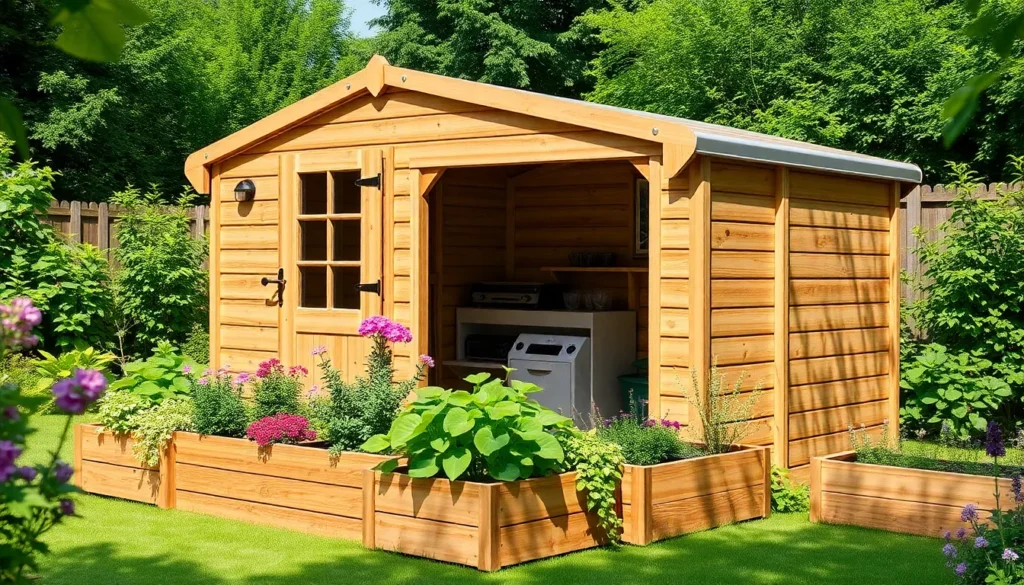Imagine living in a place where your neighbors share more than just a fence; they share a vision for a greener future. Sustainable community living isn’t just a trend; it’s a lifestyle choice that’s gaining momentum faster than a squirrel on espresso. In a world where convenience often trumps conscience, embracing sustainability can feel like a rebellious act—one that not only benefits the planet but also fosters connection among residents.
From backyard gardens to solar-powered community centers, the possibilities are as endless as your favorite Netflix binge. This article dives into the vibrant world of sustainable living, showing how communities can thrive while reducing their carbon footprint. Get ready to discover how to turn your neighborhood into an eco-friendly utopia—without sacrificing comfort or style. Who knew saving the planet could be this much fun?
Table of Contents
ToggleOverview Of Sustainable Community Living
Sustainable community living emphasizes practices that minimize environmental impact while enhancing social ties. This approach encourages residents to become actively involved in eco-friendly initiatives. Communities adopting these principles often prioritize resource sharing and local collaboration.
Gardening projects play a crucial role in sustainable living. Backyard gardens not only provide fresh produce but also create spaces for neighbors to connect. Participation in community gardens fosters a sense of belonging and responsibility toward the environment.
Renewable energy sources, such as solar power, are essential for reducing carbon footprints. Many communities are now integrating solar panels and other renewable technologies. The use of solar energy can significantly lower utility costs, making sustainability a financially viable option.
Sustainable living also includes waste reduction strategies. Composting organic waste contributes to healthier soil while minimizing landfill use. Recycling programs enhance community engagement and promote responsible consumption.
Transportation options are another key area for sustainable community living. Walking or cycling strengthens local ties and decreases reliance on fossil fuels. Car-sharing initiatives provide residents with convenient alternatives to individual car ownership.
Education plays a vital role in fostering sustainable practices. Workshops and informational sessions empower community members to make informed choices. Schools often partner with local organizations to facilitate programs that promote environmental awareness.
Creative arts can enhance the sustainable living experience. Collaborations among artists, designers, and residents often result in visually appealing and functional community spaces. Public art projects invite participation while celebrating local culture and commitment to sustainability.
Key Principles Of Sustainable Community Living
Sustainable community living revolves around essential principles that enhance both environmental health and social well-being. These guiding concepts promote a lifestyle that nurtures community ties and balances ecological needs.
Environmental Sustainability
Maintaining environmental sustainability involves adopting practices that protect natural resources. Utilizing renewable energy sources like solar power significantly reduces carbon footprints. Community gardens foster local food production, decreasing reliance on industrial agriculture. Implementing waste reduction strategies such as composting and recycling directly impacts waste management and promotes responsible consumption. Residents can form neighborhood clean-up initiatives that enhance local aesthetics while improving environmental conditions. Fostering biodiversity through native plant landscaping strengthens ecosystem resilience. Communities prioritizing environmental education create a culture of awareness that encourages future generations to maintain sustainable practices.
Social Equity
Social equity ensures all community members benefit from sustainable initiatives. Engaging diverse voices in decision-making encourages inclusive solutions that reflect various needs. Offering affordable housing options contributes to reducing economic disparities while promoting community cohesion. Accessible community spaces enhance interaction among residents, fostering stronger social ties. Cooperatives and shared resources enable equitable access to tools and services, promoting collaboration. Providing educational opportunities raises awareness and equips individuals with skills necessary for sustainable living. Advocacy for marginalized groups ensures that sustainability efforts encompass the entire community, preventing any voices from being overlooked.
Economic Viability
Economic viability emphasizes creating sustainable communities that can thrive financially. Investing in local businesses supports the economy while reducing transportation costs associated with importing goods. Job creation through green technologies and sustainable practices enhances employment opportunities. Encouraging cooperative business models allows community members to share resources and reduce operating costs. Sustainable tourism can generate income while promoting local culture and environmental stewardship. Utilizing community-supported agriculture programs strengthens local agricultural economies and provides fresh produce. These strategies create a balanced approach to economic health, elevating sustainability as a viable option for all community residents.
Benefits Of Sustainable Community Living
Sustainable community living offers numerous advantages that contribute to the overall well-being of individuals and their surroundings. This lifestyle fosters meaningful connections and promotes a healthier habitat.
Improved Quality Of Life
Sustainable community living enhances quality of life through shared resources and experiences. Residents frequently engage in community gardens, where they grow organic produce and forge friendships. Access to local markets increases the availability of fresh food, supporting healthier diets. Community workshops often provide valuable education on sustainability, encouraging lifelong learning. Recreational spaces, filled with greenery, promote relaxation and physical activity. Overall, these elements create a fulfilling environment that enhances the community’s social fabric.
Reduced Environmental Impact
Sustainable living significantly reduces environmental impact. Utilizing renewable energy sources, such as solar panels, minimizes dependency on fossil fuels, leading to lower carbon emissions. Residents often adopt waste reduction practices like composting, which diverts organic material from landfills and enriches soil. Enhanced public transportation options lessen vehicle use, further decreasing air pollution. Collaborative initiatives, such as tool-sharing programs, reduce resource consumption while fostering a spirit of cooperation. Collectively, these actions contribute to a sustainable future and protect natural ecosystems.
Challenges In Implementing Sustainable Living
Implementing sustainable living often presents various challenges that communities must address to foster effective practices.
Community Engagement
Engaging the community in sustainable initiatives can be difficult. Residents may lack awareness of eco-friendly practices, leading to minimal participation. Building a sense of ownership among community members encourages active involvement in projects. Communication plays a crucial role in informing and motivating residents, as consistent outreach can highlight the benefits of participation. Involving diverse stakeholders, including local organizations, schools, and businesses, promotes collaboration and strengthens efforts. Creating compelling campaigns to showcase success stories inspires others to become engaged. Facilitating workshops also provides hands-on experiences that deepen understanding and commitment.
Financial Constraints
Financial constraints pose significant barriers to implementing sustainable living. Communities often face budget limitations that restrict the ability to invest in green technologies or infrastructure projects. Cost-effective solutions, such as shared resources or community funds, make sustainable practices more accessible. Pursuing grants and partnerships can supplement budgets, allowing communities to access needed resources. Moreover, investing in energy-efficient systems can lead to long-term savings, making initial costs more manageable. Educating residents about the economic benefits of sustainability also encourages support for funding initiatives. Seeking local business sponsorships strengthens community ties while alleviating financial pressures.
Examples Of Successful Sustainable Communities
Sustainable communities come in various forms, showcasing innovative practices that promote eco-friendly living and strengthen community ties.
Case Study: Eco-Village
Eco-villages serve as a prime example of sustainable community living. These communities prioritize ecological design, fostering harmony between nature and residence. Residents participate in shared gardening projects, emphasizing local food production. Renewable energy systems, including solar panels and wind turbines, reduce reliance on fossil fuels. The emphasis on environmental education engages community members to adopt sustainable habits. Successful eco-villages, such as the one in Findhorn, Scotland, demonstrate how cooperation and shared resources enhance quality of life while minimizing ecological footprints.
Case Study: Urban Farm Initiatives
Urban farm initiatives create productive green spaces within city environments. These farms focus on transforming vacant lots into thriving gardens that supply fresh produce to local residents. They reduce food deserts by improving access to healthy food. Community involvement is essential; residents often assist in planting, harvesting, and maintaining these spaces. Programs like the Brooklyn Grange in New York City illustrate urban farming’s potential, combining agriculture and education to foster sustainability. Engaging workshops allow individuals to learn skills related to gardening, composting, and nutrition, enhancing community resilience.
Sustainable community living offers a path toward a healthier environment and stronger social bonds. By embracing eco-friendly practices and fostering collaboration among residents, communities can create vibrant spaces that prioritize both sustainability and quality of life.
The journey toward sustainability involves collective efforts in education, resource sharing, and innovative solutions that benefit everyone. As more communities adopt these principles, they not only reduce their environmental impact but also enhance their resilience and sense of belonging.
Ultimately, the shift toward sustainable living is not just a trend; it’s a vital movement that promises a brighter future for generations to come. Embracing this lifestyle can lead to a fulfilling and interconnected community experience.










